Example articles featuring our embeddable recommendation widget for Tumblr
Don't wanna be here? Send us removal request.
Text
6 Reasons I Love Montreal
Corbin Fraser | Backpack Canada
A city as beautiful as Montreal probably doesn’t need another travel blogger gushing over it, but I’ve never been one for expectations, which means gushing shall ensue in this post. Montreal is a very unique city to the rest of Canada. There’s something about it, the mix of old and new, the prominence of art no matter where you turn your head, and the fact that food and music play such a large part in the lives of Montrealers has been making me think that this is where I’m meant to be. At least for a while. Unfortunately, that won’t happen anytime soon, so in the meantime, I’d like to write down 6 reasons I love Montreal.

1. Good Eats Montreal Many people say you can taste the hard work and love that Montrealers put into every dish. Whether its from the baguettes at a local bakery, fresh vegetables from the Jean-Talon Market, a delicious late evening dinner at Van Horne or a 2:00a.m poutine at La Banquise. Montreal is jam packed with incredible restaurants, pubs, and deli’s. You could spend an entire summer in Montreal and barely scratch the surface of the Montreal food scene. While there are countless must-have eats in Montreal, I personally love walking down Rue Sainte-Denis or Saint-Laurent Boulevard with the sole purpose of throwing caution into the wind and trying something new out on a whim.

2. Montreal Culture The fact that Montreal is the most well known bilingual city in Canada, and that housing and commerce mix seamlessly throughout all of downtown, encouraging a populated downtown feel, it’s no wonder Montreal is known to many as the cultural capitol of Canada. It truly is a unique city, different than all others in Canada. Besides being one of the most walkable cities in Canada, the city boasts a massive art & music scene that continues to showcase Canada as more than just hockey-loving lumberjacks. Did I mention Montreal (and Quebec in general) have escaped the draconian liqueur laws that the rest of Canada – excluding Newfoundland – have to deal with. Wander down to any corner store (or Dépanneur en français), and grab a case of beer or a bottle of wine. No questions asked. This is my type of city.
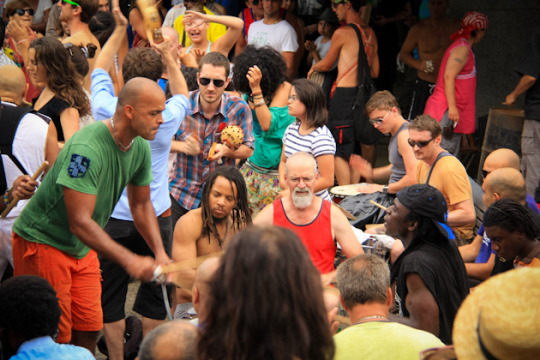
3. Montreal Tam-Tams The Montreal Tam-Tams are something I came across this summer. Something I’d never heard about, but after being in the city for a few days, I kept hearing it from everyone I spoke to. “You have to see the Tam-Tams!” locals would proudly exclaim. Thousands of Montrealers gather each Sunday at the George-Étienne Cartier Monument in Mount Royal Park and proceed to start a massive drum & dance circle. If you can’t drum, you dance, and if you can’t dance, you smoke pot or have a beer, and if you don’t smoke or drink, you play frisbee or just people watch. It’s a mix of artists, hippies, stoners, musicians, and those young, and young at heart who gather to be a part of something during the summer. Tam-Tam’s start around 1pm and continue until sunset. They’re free to the public, just show up and join in on the festivities. If drum circles aren’t really your thing, there’s also a DJ Booth setup for fans of electronic music, or if music in general isn’t your cup of tea, head back into the woods and watch the LARPers (Live Action Role Players) beat the crap out of one another with swords and shields. Note: Drinking in public is technically illegal, so be careful. It’s sort of an unwritten law that nobody will rat you out at Tam Tams, just be sure to only bring cans, and don’t try to be the drunkest guy in the park. Also, pot isn’t legalized in Canada, no matter what anybody tells you. Just use common sense.
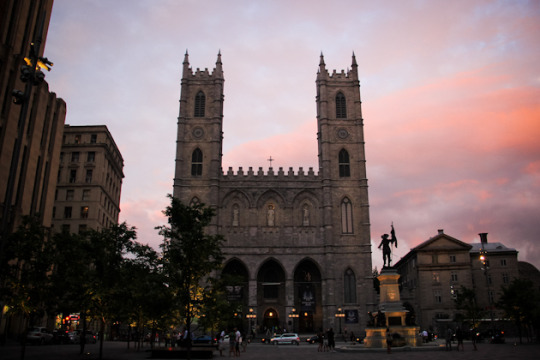
4. The Streets of Old Montreal Walking around Old Montreal during lunch, or even better, at sunset is the perfect way to see why Montrealers are so proud of this magnificent city. Between the countless patios & restaurants, the fresh air, the open park space, the gentle breezes rolling off the Fleuve Saint-Laurent, or the steady buzz of people relaxing and talking, it’s easy to see why so many fall in love with this city.

5. Montreal is a Bike-friendly City No Canadian city does bikes quite like Montreal. During the summer months, and even the winter months for many, bikes (or Les Vélos en français) are the best way to get around. If you’re just visiting the city, don’t worry, BIXI will have you covered. BIXI’s (which stand for Bike-Taxi) are located throughout the city, and with a quick swipe of your credit card you’ll be on your way with your very own bike. Return the BIXI to any of the countless BIXI stands and carry on with your day. It’s a great way of getting from “Point A” to “Point B”, while burning off a couple of extra calories. Bike paths are found nearly everywhere in Montreal, ensuring minimal interaction between bike and car.

6. The Multitude of Montreal Festivals Montreal is a city filled with festivals. No matter what time of year, there’s something for everyone. Whether you’re a music junkie, a fan of contemporary art, a sci-fi geek, a film-buff, Montreal can deliver. I was recently in Montreal for POP Montreal International Music Festival with 4 other travel bloggers, and managed to catch a few shows. With the ease of getting around by foot, bike, or public transportation, it’s easy to squeeze in countless awesome indie acts. For the last couple of years I’ve been telling myself, “I’m going to live in Montreal someday“. Lately, I can’t help but think that might actually pan out. With each visit to Montreal, I find myself loving the city more and more. There’s so much to see and do in Montreal, I worry that I’m missing out on experiencing one of the most culturally diverse cities in Canada. In the meantime, I’ll just have to enjoy it from afar.
More articles and videos about Montreal and travel...
0 notes
Text
Culture is the Behavior You Reward and Punish
Jocelyn Goldfein | Medium

Some lessons creep up on you gradually; others hit you over the head like an anvil.
At the outset of 2008, VMware was flying high. We were a Silicon Valley rocket ship; we’d doubled revenue and headcount for four years in a row. We were an upstart disrupting the datacenter, we were thriving despite every effort of powerful incumbents determined to stop us. We had lots of growing pains, but they were all “good problems to have.”
Our CEO collected a few dozen of her senior-most staff and rising young leaders, and took us to Half Moon Bay for an offsite to discuss the future of the company.
Charles O’Reilly of Stanford GSB came for a workshop and gave us a simple exercise: “Here you all are, VMware’s best and brightest. You’ve built this incredibly successful company, what an achievement! Now, imagine I’m a new hire, a protégé of yours, and I show up in your office on my first day of work, and I ask you ‘So what should I do to get ahead at VMware? What makes people successful here? What made you successful?’”
We filled his whiteboard, at first with the expected: “innovate!” “work hard!” “be open and collaborative!” “work with quality” “attention to detail!” “VMware first — don’t be personally selfish.” With more prompting, and we copped to some of the less self-valorizing truths: “be available on email 24x7!” “sound smart” and “get consensus on your decisions.”
Before you read onwards you might want to try this exercise for yourself, about your own company. Go ahead, I’ll wait.
When we finished, O’Reilly pointed at the whiteboard with a magician’s flourish: “That’s your culture. Your culture is the behaviors you reward and punish.” At first, I was stunned. When I thought of culture, I thought of big mission statements and values, like our emphasis on innovation. Or our social traditions — like Friday afternoon beer bash, or tossing the newly affianced into the campus fishpond. I didn’t think of responsiveness to email.
My second reaction was embarrassment. There was a glaring omission on the whiteboard: none of us had brought up customers. If O’Reilly had asked us about culture, we’d certainly have said “customer oriented.” But he’d asked how to succeed at VMware, and so we gave the true answer of what our culture actually was, not what we thought it should be.
New hires don’t walk into your company already knowing your culture. They walk in anxious — hoping for success and fearing failure. They look around them to figure out how they are supposed to behave. They see who’s succeeding, and they imitate what they’re doing as best they can. They figure out who’s failing, and they try to avoid being like them.
Compensation helps very little when it comes to aligning culture, because it’s private. Public rewards are much more influential. Who gets promoted, or hangs out socially with the founders? Who gets the plum project, or a shout-out at the company all-hands? Who gets marginalized on low-value projects, or worse, fired? What earns or derails the job offer when interview panels debrief? These are powerful signals to our teammates, and they’re imprinting on every bit of it. When all the “successful” people behave in the same way, culture is made. At Facebook, “data driven” was a critical value, and across the board, Facebook leaders uniformly make decisions informed by data and listen and respect dissenting arguments when they are presented with data.
When role models are consistent, everyone gets the message, and they align towards that expectation even if it wasn’t a significant part of their values system before joining the company. That’s how culture gets reproduced, and how we assimilate new co-workers who don’t already possess our values.
People stop taking values seriously when the public rewards (and consequences) don’t match up. We can say that our culture requires treating each other with respect, but all too often, the openly rude high performer is privately disciplined, but keeps getting more and better projects. It doesn’t matter if you docked his bonus or yelled at him in private. When your team sees unkind people get ahead, they understand that the real culture is not one of kindness. It ends up being asymmetrical: it takes unanimity to establish a positive norm in your culture, but it only takes a little inconsistency to lose it. When successful people diverge from one another (for example, a mix of rude and kind people), then there is no clear pattern established for others to follow. Your culture is simply mute on the topic, and it’s up to individuals to choose based on their own inclinations or perhaps the most influential leader in their area.
This is why CEOs can seem so sincere making statements like “There’s no place for arrogance in our culture” while individuals in their company continue to exhibit lots of arrogant behavior. Your role models may not uniformly be arrogant. You may not role model arrogance yourself, as CEO. The starting point may very well have been “a few bad apples.” But if you didn’t build a consistent culture of humility, you failed to build an immune system against arrogance.
If you try the Charles O’Reilly exercise on your teammates, like VMware’s execs, you’ll probably find some discrepancies between the culture you have and the culture you want. That learning is a gift; you can use it to change for the better, no matter where you fit in your company.
Team members: even without a formal leadership role, you can affect your company’s culture. You might not control compensation or promotions, but you have a powerful incentive at your fingertips: praise and criticism. Wield them thoughtfully and you can be a culture carrier who transmits and strengthens company values.
Managers: Most day-to-day incentives are controlled by team leads and managers, making you the central nervous system of company culture. Managers need to realize that your decisions are getting absorbed by everyone around you: Laura got a stretch project. Shawn got transferred. Jing attended the Director’s meeting in your place when you were traveling. The decisions may be nuanced, but perceptions won’t be. Be judicious about the tradeoffs you’re making.
Founders/CEOs: Once a company scales, founders and CEOs have little control over day-to-day incentives — but you still have disproportionate cultural impact. Your company sees you as the embodiment of company values. That’s high stakes: if you dither over decision making, you can expect your team to have trouble getting things done. It’s also a super power. If a CEO spends an hour on the phone taking customer support calls, then everyone gets the message that making things right for customers is everyone’s job.
Culture is powerful. It makes teams highly functional and gives meaning to our work. It’s essential for organizational scale because culture enables people to make good decisions without a lot of oversight. But ironically, culture is particularly vulnerable when you are growing quickly. If newcomers get guidance from teammates and leaders who aren’t assimilated themselves, your company norms don’t have a chance to reproduce. If rewards like stretch projects and promotions are handed out through battlefield triage, there’s no consistency to your value system.
Times of high growth are when you need to be most deliberate about your culture, but if you start early and stay relentless, you’ll be able to depend on it when you need it the most.
More great articles about corporate culture and entrepreneurship...
0 notes
Text
In the future we’ll work from wherever we want
Neil Balthaser | Medium

The days of the centralized office or in some cases the “campus” are numbered. I don’t say this with much glee or malice in my heart. It’s just that I’ve seen the light and I know where things are heading.
I’m trying something new with my current company, Intellogo. I’ve resisted the urge to get an office even when we’ve grown. Everyone at Intellogo works from wherever they want. We don’t police anyone. Some people will rent a personal workspace at shared facilities; some like to work from their local library. I like to work from my home office but have a mobile office that I like to take out to beautiful and scenic locations on occasion.
The value of being able to work from wherever you want is that you’re more productive. Sometimes you want to be around others, great rent a workspace in a shared environment. Want peace and quiet? Great, work from the library. Need a space to be creative? Great, take the mobile office out to your favorite spot.
For those times when we need to meet as a team, we rent hourly conference rooms using Breather. Breather started here in Montreal but is expanding to U.S. cities and now has awesome spaces in New York city and San Francisco.
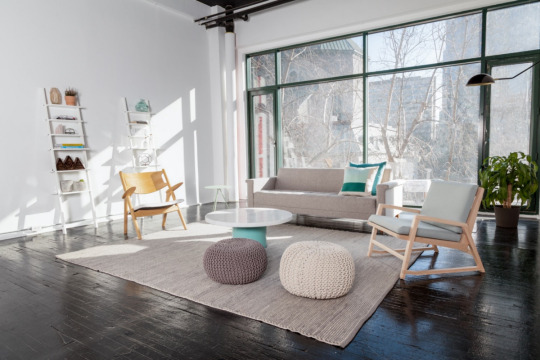
One of our favorite Breather meeting rooms in Montreal — Breather offers temporary meeting areas rented out by the hour
Most of our other communication needs are done via Skype and increasingly Slack. We’ve mastered the virtual meeting having done it so often. A virtual knock on my office door via Skype is as good as the real thing. We use OneDrive, Google Docs, Office Online, Zoom, whatever gets the job done. The end result is less time spent commuting. Less time spent in meetings. Less money spent on offices. More time spent being productive and creative. After I drop my daughter off at school, my morning commute consists of walking upstairs. At 5pm, I wander downstairs and join the rest of the family. I have a more balanced life and I’m happier.
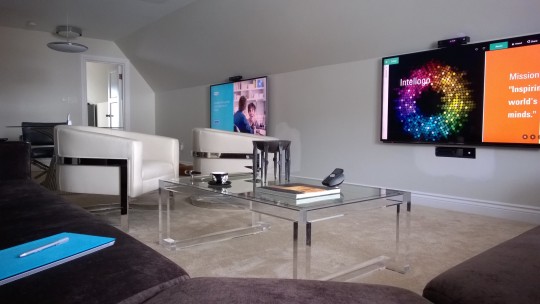
Your home office can adapt to your needs — a comfortable video conferencing area since we do so much of it
Addendum
In my time in Silicon Valley I have experienced some of the nicest campuses there. I was barely a teenager when my dad moved the family from Ohio to work at Atari. In those days Atari was bigger than Apple and had multiple campuses spread across the valley. My friends and I would hop the corporate shuttle from one campus to another to play free video games in the lobbies of buildings. There weren’t enough hours in the day to hit them all.
Later I had the great privilege of working at Apple. By that time Atari’s greatness had faded and Apple was the new darling of the valley. Apple also had several campuses and a lot more money. Every Friday different departments threw beer bashes on their mini-campuses. I remember one where they brought in Tyco drummers and were giving away free gifts and all the booze and food you could want. Those were the days.
Most recently, I was a senior executive at Barnes and Noble when we leased five buildings in the old Xerox Parc campus for our Nook division. No expense was spared renovating those buildings. A beautiful campus tucked away in the hills of Palo Alto with polished white interiors and glass offices that would have made Stanley Kubrick and Arthur C. Clark proud.
Still, I wouldn’t trade this view of the bay for any of those campuses…
More articles about work flexibility...
0 notes
Text
This Giant Tower in the Desert Could Generate As Much Power As Hoover Dam
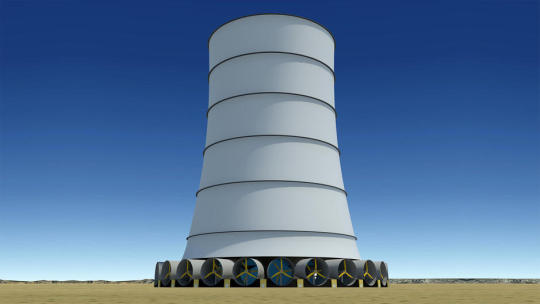
Ben Schiller | FastCompany
If the Solar Wind Downdraft Tower is ever built in the Arizona desert, it truly will be a wonder of the modern world. At 2,250 feet, it would be taller than the new Freedom Tower in New York (1,776 feet), and 1,000 feet higher than the Empire State Building. It would have 120 huge turbines at its base, and enough pumping capacity to keep more than 2.5 billion gallons of water circulating. And it would have colossal power output: the equivalent of wind turbines spread over 100,000 acres, or as big as the Hoover Dam.
That's the plan, anyway.
The idea goes like this: Water is sprayed at the top, causing hot air to become heavy and fall through the tower. By the time it reaches the bottom, it's reaching speeds of up to 50 miles per hour, which is ideal for running the turbines. The advantage over standard solar and wind energy is the plant runs continuously, day and night. There are no intermittency issues from the sun failing to shine, and you don't need to dust off any solar panels to keep things going. As long as the air is warm enough (which is likely in Arizona), the tower will keep creating draft effects.
The plant itself runs under its own generated energy: about 11% of output goes to pumping the water to the top again, and about three-quarters of the water is collected at the bottom, according to Ron Pickett, CEO of Solar Wind Energy Tower, the Maryland company behind the design.
"This is totally clean energy that actually makes money," he says in an interview. "It makes energy at a cost comparable to if you were using natural gas to power a plant."
In a sense, the technology is the least complicated thing. People have been working on variants of solar wind towers for more than a century. In the 1980s, engineers in Spain built a 640-foot test tower that pushed air upwards through turbines (by warming the air). It generated power for seven years until it fell over in a storm.
The tougher issue is the enormous expense. To start generating meaningful amounts of power, you need something very large, and very large things tend to be costly. The Arizona project is likely to cost as much as $1.5 billion, according to Pickett.
See a company video here:
youtube
Learn more about this story by clicking an article below...
0 notes
Text
Under Golden Arches in Italy, a Tract of Roman Road
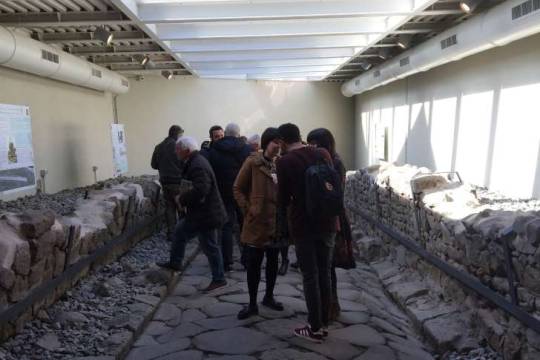
© Elisabetta Povoledo | The New York Times
It’s a common enough story in Italy: An ancient ruin — in this case, a tract of Roman road — is discovered during the construction of a building — in this case, a McDonald’s — and puts a halt to the work until the site can be excavated.
Rather than fret about lost time and money, McDonald’s decided to sponsor the dig, and it worked with the archaeological authorities to preserve the road, built between the second and first centuries B.C.
As of Tuesday, visitors to the fast-food restaurant, about 12 miles southeast of central Rome, could walk along the 147-foot stretch of road without even having to buy a Big Mac.
Many parts of Italy contain subterranean riches, and over the centuries, countless edifices have incorporated or adapted the ruins of previous eras. Several restaurants in Rome, for example, have an important historical or archaeological lineage, like being the site where Julius Caesar was murdered, or a place where oil amphorae were stocked in ancient times. Even the McDonald’s in Termini Station in Rome includes a section of the Servian Wall, from the fourth century B.C.
But the work at the McDonald’s in Marino — more precisely in the hamlet of Frattocchie, known as Bovillae in ancient times — stands out because the project incorporated the road, which would otherwise have been reburied. “Archaeology is constantly bringing to light testimonies of the past that have to be documented in an exacting manner but can’t always be properly preserved,” said Alfonsina Russo, the Culture Ministry’s archaeological superintendent for the area.
In many cases, unless the archaeological finds are exceptional, they are reburied in the hopes that they can be re-examined later. “It’s better to protect them than to leave them exposed, when it’s not possible to properly care for them,” Ms. Russo explained. “The earth protects, man destroys.” The finding of the road, uncovered in 2014 while digging for the foundations of the McDonald’s, came as a surprise. “We decided with McDonald’s to protect and promote this important site, which would have otherwise fallen again into oblivion,” Ms. Russo said.
The road was a diverticulum, or side passage, leading to the Appian Way, an ancient Roman thoroughfare built in 312 B.C. The uncovered stretch probably led to a villa or a great estate, Ms. Russo said.
Archaeologists who worked on the dig have said that the unearthed road, which has grooved signs of ancient wear and tear from cart wheels, was most likely used for a few hundred years before it was abandoned. The skeletons of three adult males found in the gutter of the road, which have been reproduced in resin casts, are signs that the road had been abandoned, said an archaeologist involved in the effort, Pamela Cerino.
The skeletons, which have yet to be dated through carbon testing, were found with items including terra cotta tiles, that led to the hypothesis that the road stopped being used in the second or third centuries A.D., Ms. Cerino said. She was hired by McDonald’s but worked under the supervision of the Culture Ministry, as is usually the case in Italy when private property is involved. McDonald’s spent around 300,000 euros, or about $315,000, on the restoration project.
The road was excavated, documented and enclosed in a gallery with a glass roof, so that patrons of the restaurant can look down on it. The entrance to the gallery is separate and can be visited by anyone, not just McDonald’s customers.
Given its remoteness from major attractions, the site is unlikely to attract many tourists, although explanatory panels in Italian and English have been installed throughout the site. School groups from nearby towns began arriving on Tuesday, when the site officially opened to the public.
The gallery is closed off by a gate and monitored with surveillance cameras, and McDonald’s Italia has pledged to pay for its upkeep. “That’s the most important thing, guaranteeing its constant maintenance,” said Ms. Russo, who added that Culture Ministry officials would periodically check on the site.
“It’s easy to excavate, the more critical operation is to preserve a site,” she said.
“We’re proud to be here, giving this Roman road,” said Mario Federico, managing director of McDonald’s Italia, who said it was the first time the restaurant chain had encountered the need for “a solution of this kind” in Italy.
Asked if he thought hungry patrons would be squeamish about seeing skeletons on display below, he said it was unlikely.
If you enjoyed this article you might also like these...
0 notes
Text
Timelapse Footage of Sweating Fingerprints Ready to Smear Your Smartphone

Andrew Liszewski | Gizmodo
Thousands of nearly invisible sweat pores live amongst the spiraling ridges on your fingertips. They only reveal themselves if you’re patient enough to wait for them to start working. Luckily, the good folks of YouTube’s Timelapse Vision Inc. channel were kind enough to create footage of sweating fingerprints that look like a car crash: you don’t want to look at it, but once you do, it’s impossible to look away.
Using a macro lens on a timelapse camera, we can see the sweat pores responsible for all the fingerprints you leave behind, like when people leave bloody fingerprints at murder scene or when you smear your smartphone’s touchscreen. The next time you’re wiping something clean, remember this footage, and the battle you’ll never win.
[Gizmodo via YouTube via Geekologie]
Here’s some more great articles...
0 notes
Text
Walt Disney’s Retro-Futurism
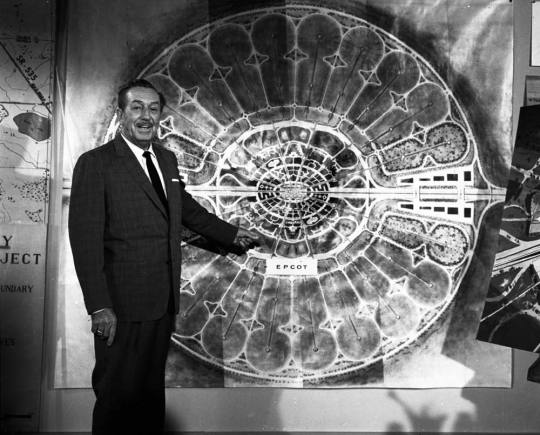
Do you know that the king of retro-futurism is Walt Disney? Most retro-futurists are content to muse about what the future could bring -- Walt Disney was about to build it.
While the current EPCOT theme park in Disney World is a showcase for retro-futuristic technologies, its original goal was to be an actual city. EPCOT stood for the Experimental Prototype Community of Tomorrow. It was to be the centerpiece of Walt Disney World where 20,000 people would live and work in a master-planned community designed by Walt Disney himself. It featured such futuristic concepts as: an underground highway system, a completely enclosed and temperature controlled city center, an intermodal transportation system linking monorails and WED-way people movers and a centralized, automated and underground garbage collection and rapid transit system. Sadly, Walt Disney died before construction on EPCOT could begin. Without his vision and leadership, Disney corporation decided to scale back his ideas to what we have today. Makes you wonder what could have been.
Check out these other interesting articles ...
0 notes